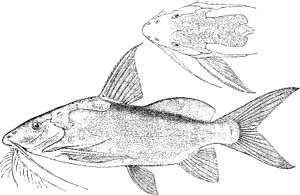Synodontis geledensis facts for kids
Quick facts for kids Synodontis geledensis |
|
|---|---|
 |
|
| Conservation status | |
| Scientific classification | |
| Genus: |
Synodontis
|
| Species: |
geledensis
|
The Synodontis geledensis, also known as the Geledi squeaker, is a special kind of catfish. These fish are sometimes called "upside-down catfish" because of how they swim! You can find them in rivers and swamps in Ethiopia, Kenya, and Somalia. They live in places like the Lorian Swamp, the Shebelle River, and the Ewaso Ng'iro River. A German scientist named Albert Günther first described this fish in 1896. He found the first fish near a place called Geledi in Somalia, which is why it's named geledensis.
What the Geledi Squeaker Looks Like
Like other Synodontis fish, the Geledi squeaker has a strong, bony head. This head bone goes all the way back to its first fin on its back. It also has a unique bony bump on its head called a humeral process. The shape of this bump helps scientists tell different Synodontis species apart. For the Geledi squeaker, this bump is rough and pointed. It is also much longer than it is wide.
This fish has three pairs of feelers, called barbels, around its mouth. One pair is on its upper jaw, and two pairs are on its lower jaw. The upper feelers are straight and have a wide base. They are about one and a quarter times as long as the fish's head. The outer pair of lower feelers is twice as long as the inner pair. These outer feelers have long, thin branches.
The front edges of the fins on its back and sides are stiff and spiny. The spine on its back fin is nearly straight and about four-fifths as long as its head. It has small bumps on the front edge but is smooth on the back. The rest of this fin has seven soft, branching rays. The spine on its side fin is as long as its head and has bumps on both sides. The small, fleshy fin near its tail, called the adipose fin, is four times longer than it is deep. The fin on its belly has four unbranched and eight branched rays. This fin is somewhat pointed at the front. Its tail fin is deeply split, like a fork.
All Synodontis fish have a special pad of teeth on the front of their upper jaw. This pad has several rows of short, chisel-shaped teeth. In the Geledi squeaker, this tooth pad is short and wide. On its lower jaw, the teeth are attached to flexible stalks. These teeth are shaped like an "s" or a hook. The number of teeth on the lower jaw helps identify the species. The Geledi squeaker has about 18 teeth on its lower jaw.
The fish is brownish on its back and sides. Its belly is whitish. The biggest Geledi squeaker ever found was about 30.7 centimeters (about 12 inches) long. Generally, female Synodontis fish are a bit larger than males of the same age.
Where They Live and How They Behave
In the wild, Geledi squeakers are found in Kenya and Ethiopia. Scientists think they might live in even more places. People sometimes catch these fish for food. Their homes are at risk because of dams being built and water being used for farming. This can make their rivers and swamps have less water.
Scientists don't know much about how most Synodontis fish reproduce. They have found eggs in some female fish, which gives them clues. It's likely that these fish lay their eggs during the rainy season, usually from July to October. During this time, pairs of fish might swim together to lay eggs. Young Geledi squeakers grow quickly in their first year. After that, their growth slows down as they get older.


